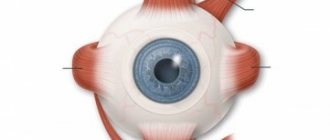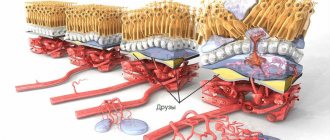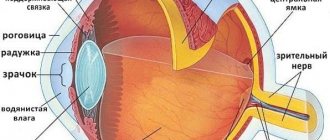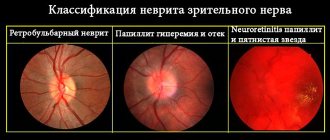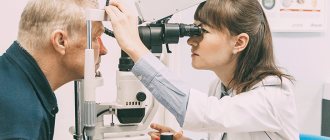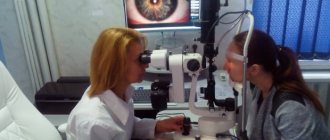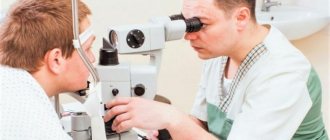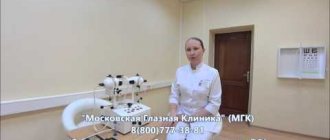Ophthalmologist, Ophthalmosurgery
Gevorkyan
Armine Seyranovna
15 years of experience
Ophthalmologist, highest qualification category, member of the Russian Society of Cataract and Refractive Surgeons (RSCRS) and the European Society of Cataract and Refractive Surgeons ESCRS
Make an appointment Author of the article: Gevorkyan Armine Seyranovna, Ophthalmologist, highest qualification category, member of the Russian Society of Cataract and Refractive Surgeons (RSCRS) and the European Society of Cataract and Refractive Surgeons ESCRS
Optic nerve atrophy is an eye disease that is characterized by weakened vision due to the development of pathological processes affecting the nervous part of the organ. In other words, with atrophy, the optic nerve fibers gradually die off, and information from the retina is supplied to the brain in a distorted form. This pathology can occur for many reasons, most of them are associated with the presence of ophthalmological diseases. We will tell you what symptoms the disease has, how it is diagnosed, and what the cost of the operation is.
Optic nerve atrophy: what is it, causes, how to treat
The optic nerve is a kind of “path” along which impulses generated during the perception of images pass. If any part is “blocked”, that is, atrophy occurs, then the image is not conveyed accurately. Unfortunately, this pathology can occur in people of any age. Not so long ago, when doctors diagnosed atrophy, they simply refused to treat the patient. The progressive development of atrophy ended in blindness, as doctors believed that it was impossible to restore the optic nerve tissue.
Modern diagnostic methods have made it possible to study the disease in detail, and ophthalmologists have come to the conclusion that if the fibers are not completely subject to atrophy, then it is quite possible to restore them. It is enough to identify the symptoms in a timely manner and perform surgery. Therefore, if a person’s vision deteriorates, he should immediately contact a specialist. This disease is treatable.
Types of optic nerve damage
The causes of atrophy are considered to be ophthalmological diseases and various pathologies. But there are several main types:
hereditary In case of DNA mutation, the presence of Bourneville syndrome and a number of other diseases, diseases of the optic nerve can manifest themselves as a side effect. Getting rid of symptoms is easy if you eliminate the underlying cause;
acquired. Divided into primary and secondary types. If peripheral neurons are compressed, the primary type of atrophy develops. In this case, the eye disc remains unchanged. If disc swelling occurs, secondary atrophy develops. Also, due to intraocular pressure, glaucomatous form can occur.
There are 3 stages of optic nerve disorder: initial, incomplete, complete. The disease can be stationary or progressive.
Symptoms of optic atrophy
Optic nerve atrophy manifests itself quite clearly, but in children it is more difficult to determine the pathology. If the optic nerve is damaged at an early age, the child may simply not realize that he perceives the world differently. Therefore, you should regularly visit doctors and undergo examinations. There are main symptoms indicating optic nerve atrophy:
- so-called dark spots appear before the eyes, a feeling of interference is created, as if something is in front of the eye in the field of vision;
- Central vision is significantly reduced with primary optic atrophy, which can lead to complete blindness. Therefore, it is necessary to make timely diagnosis and undergo treatment;
- you may notice a narrowing of the field of view;
- Sometimes it becomes quite difficult to distinguish colors.
If at least one symptom appears, this can serve as a bell that indicates the presence of optic nerve atrophy. Remember that in the early stages the treatment process gives tremendous results, up to the complete restoration of the optic nerves. It is necessary to correctly identify the disease and prescribe a treatment package that allows you to restore the nerve. This can be done in our clinic.
Causes of atrophy
Optic nerve atrophy often does not occur on its own. It has its own reasons, which include:
- development of dangerous infectious diseases (meningitis, syphilis, herpes);
- serious traumatic brain injuries;
- mechanical damage to visual tissues and fibers;
- diseases that affect the nervous system, these include multiple sclerosis;
- alcohol poisoning: so-called “blindness” from alcohol;
- disruption of circulatory processes, especially in visual tissue;
- oncological diseases that compress part of the nerve and provoke the development of atrophy;
- disturbances in the fusion of skull bones after fractures;
- increased intraocular or intracranial pressure;
- development of glaucoma;
- vascular diseases that disrupt nutritional processes: vegetative-vascular dystonia, atherosclerosis, severe vascular spasms;
- brain diseases.
It is worth noting that optic nerve atrophy can develop even with a common cold. Monitor changes and symptoms. If they appear, you should immediately contact an ophthalmologist. You can lose your sight simply due to inattention to your health. Visit JSC "Medicine" (academician Roitberg's clinic) and undergo a comprehensive examination to find out if the visual fibers are in order. This is also recommended for preventive purposes.
Why is optic nerve atrophy dangerous?
The optic nerve can be thought of as a telephone wire. On the one hand, there is the retina, on the other, the part of the brain responsible for image perception. Inside this “wire” there are a large number of fibers that provide reliable communication. If the fibers begin to tear or become deformed, this bond will deteriorate significantly. If the optic nerve is damaged, it is necessary to select a position in which the image becomes clearer.
Atrophy entails a number of consequences:
- a person ceases to perceive colors;
- blindness develops;
- regular headaches occur;
- there is pain in the eyes;
- the field of view narrows significantly, you have to constantly choose an angle to look around.
There are enough reasons to contact an ophthalmologist in a timely manner and begin the treatment process. There is no need to neglect your health; optic nerve atrophy is quite easy to treat while it is at an early stage.
Symptoms
Each form of atrophy exhibits its own characteristic symptoms that create a clinical picture. However, the disease is characterized by general symptoms:
- Visual acuity decreases . Similar symptoms occur in all children with atrophy. Initially, the child experiences a deterioration in visibility, after which other symptoms appear - impaired color perception, decreased image sharpness, etc.
- Narrowing of the field of view . Occurs in later stages, when previous symptoms have existed for a long time. The child cannot examine everything entirely; to do this, he turns his head.
- Painful sensations in the eye . Symptoms of pain are characteristic even in the earliest stages, especially when the field of vision is narrowed.
- Appearance of spots before the eyes . Symptoms appear in the later stages - black circles appear in the field of vision, blocking the whole picture.
Diagnosis of the disease
Optic atrophy is diagnosed through a series of tests by an ophthalmologist. Additionally, consultation with a number of other specialists, in particular a neurologist and neurosurgeon, may be required. In order to make a diagnosis, the following procedures are performed:
- angiography of cerebral vessels. It allows you to determine the area in which atrophy develops;
- X-ray of the skull. The doctor looks to see if there is compression of the nerves due to bone deformation or other disorders;
- MRI. Allows you to accurately assess the condition of the optic nerve and examine the fibers;
- ophthalmological examination. The structure of the eye disc is studied;
- computer perimetry. The procedure allows us to understand which part of the nerve is damaged.
The doctor may also prescribe a number of other examinations to get a more accurate picture. After this, treatment of optic nerve atrophy begins, as a rule, it is very successful. But it is worth noting that it will not be possible to completely eliminate atrophy and restore the body. The doctor's task is to restore as many fibers as possible. But the earlier the presence of atrophy is determined, the higher the likelihood of success.
For any damage to the optic nerve, treatment is necessary, since ignoring the disease leads to partial or complete loss of vision. Then it will be almost impossible to restore it.
Which doctors treat atrophy?
Not everyone knows which doctors treat atrophy. Ophthalmologists are involved in restoring vision and getting rid of optic nerve atrophy. They are the ones who identify the disease and help restore vision. But sometimes the services of a neurologist and neurosurgeon are required. These specialists perform a number of procedures necessary for the patient's recovery.
Our clinic employs highly professional specialists with extensive experience who will help get rid of optic nerve atrophy. All that remains is to see a doctor and get medical help.
Treatment of optic atrophy
Atrophy is called damage to the optic nerve, and experts assure that it is almost impossible to completely restore the organ’s full functioning. This is true, but it is possible to get as close as possible to a successful result. For this purpose, complex treatment of optic nerve atrophy is carried out. The following methods of influence are used:
- Magnetic stimulation. The specialist acts on the organ with an alternating magnetic field. This significantly improves blood supply and activates various metabolic processes in tissues. The healing process is accelerated, this method helps with treatment in the early stages. 10-15 sessions are enough to completely restore vision.
- Electrical stimulation. Using a special needle, an electrode is inserted into the eyeball, which creates electrical impulses. The second electrode is fixed on the skin. The procedure is carried out for 2 weeks, after which a break is taken. It helps restore vision gradually; the process must be repeated every 3 months. Technologies make it possible to introduce a miniature electrical stimulator into the eyeball, which works for several years. This is a great way to get rid of atrophy.
- Traditional therapy. It includes blood transfusions, the use of vasodilators, and the use of vitamin B. If optic nerve atrophy is caused by a bacterial disease, the doctor prescribes a course of antibiotics and the use of antiviral drugs.
- Physiotherapy. Helps improve overall health and complements the main complex. To restore the optic nerve, electrophoresis, oxygen therapy, ultrasound and other methods of influencing the body are used.
- Surgical intervention. It is used if it is necessary to establish the supply of beneficial microelements to the damaged area. Also, the process of implanting an electrical stimulator requires the intervention of a surgeon.
All these methods allow us to eliminate the reasons why the disease develops. After all, you first need to remove the focus that provokes optic nerve disorders, and only after that restore the fibers.
It is also worth listening to preventive recommendations, this will prevent atrophy from developing:
- It is imperative to treat various diseases, even if it is just a common cold; any virus can harm the body and trigger processes of damage to the optic nerve;
- avoid injuries, especially traumatic brain injuries;
- You should regularly visit an ophthalmologist and undergo a basic examination;
- It is worth giving up bad habits, especially drinking alcohol; poisons contained in alcoholic beverages often provoke the development of atrophy;
- You should actively engage in sports, especially swimming.
By devoting a little time to yourself, you can protect your body from pathological problems. There is no need to neglect going to the doctor; timely identification of the problem will allow it to be quickly eliminated.
Diagnostics
As a rule, problems with detecting this pathology rarely arise. The main thing is that the patient seeks medical help in a timely manner. To confirm the diagnosis, he is referred to an ophthalmologist for a fundus examination. This is a special technique with which you can examine the initial part of the nerve trunk.
How is ophthalmoscopy performed ? In the classic version, the fundus is examined by a doctor in a dark room, using a special mirror device (ophthalmoscope) and a light source. The use of modern equipment (electronic ophthalmoscope) allows this study to be carried out with greater accuracy. The patient is not required to have any preparation for the procedure or special actions during the examination.
Unfortunately, ophthalmoscopy does not always detect changes, since symptoms of damage occur earlier than tissue changes. Laboratory tests (blood, urine, cerebrospinal fluid tests) are nonspecific and have only auxiliary diagnostic value.
How to proceed in this case? In modern multidisciplinary hospitals, to detect the cause of the disease and changes in nervous tissue, the following methods exist:
| Research method | Principle of the method | Changes in atrophy |
| Fluorescein angiography (FA) | The patient is injected with a dye through a vein, which enters the blood vessels of the eyes. Using a special device that emits light of different frequencies, the fundus of the eye is “illuminated” and its condition is assessed. | Signs of insufficient blood supply and tissue damage |
| Laser eye disc tomography (HRTIII) | Non-invasive (remote) way to study the anatomy of the fundus. | Changes in the initial part of the nerve trunk according to the type of atrophy. |
| Optical coherence tomography (OCT) of the optic nerve head | Using high-precision infrared radiation, the condition of tissues is assessed. | |
| CT/MRI of the brain | Non-invasive methods for studying the tissues of our body. Allows you to obtain an image at any level, with an accuracy of cm. | Used to determine the possible cause of a disease. Typically, the purpose of this study is to look for a tumor or other mass formation (abscesses, cysts, etc.). |
Treatment of the disease begins from the moment the patient contacts, since it is irrational to wait for diagnostic results. During this time, the pathology may continue to progress, and changes in tissues will become irreversible. After clarifying the cause, the doctor adjusts his tactics to achieve the optimal effect.
Indications
Treatment indications include:
- the presence of one or more symptomatic manifestations;
- head injuries or mechanical damage to the eye;
- regularly occurring headaches;
- dizziness, partial loss of vision;
- blurred vision;
- emerging eye fatigue.
If you have indications, you should contact a specialized center that will provide assistance. Don’t waste time, call our clinic and make an appointment with an ophthalmologist.
Symptoms and diagnosis
Symptoms of the pathology are gradually or acutely occurring cases of decrease and loss of vision. You can also note the development of double vision (especially if the lesion is one-sided), blurred and blurred contours of objects, and constant nystagmus. Nerve damage can be diagnosed by ophthalmoscopy (blanching of the nerve disc is revealed). Targeted MRI examination of the orbit allows for the clearest visualization of lesions and the extent of damage. Often, pathology is detected during a routine examination by an ophthalmologist as an accidental finding.
Contraindications
Despite the fact that the disease requires treatment, it is not always possible to use all methods. There are a number of contraindications in which elimination of optic nerve atrophy is impossible:
- during pregnancy, doctors recommend postponing the procedure, as with breastfeeding; in exceptional cases, it is allowed to treat the eyes, but only under the strict supervision of a doctor;
- contraindications to the use of drugs included in the drug complex;
- complex head injuries that have not yet healed;
- severe infection, presence of active disease.
The doctor may also prohibit or limit the course of vision restoration for other reasons. A specialist will tell you about all this, based on the individual characteristics of each patient.
Causes
Optic nerve atrophy is not an independent disease, but is a consequence of some pathological process in the patient’s body.
Optic atrophy
The main causes of the disease include:
- Eye diseases (diseases of the retina, eyeball, eye structures).
- Pathologies of the central nervous system (brain damage due to syphilis, brain abscess, skull injury, brain tumors, multiple sclerosis, encephalitis, meningitis, arachnoiditis).
- Diseases of the cardiovascular system (cerebral atherosclerosis, arterial hypertension, vascular spasm).
- Long-term toxic effects of alcohol, nicotine and drugs. Alcohol poisoning with methyl alcohol.
- Hereditary factor.
Optic nerve atrophy can be congenital or acquired.
Congenital optic atrophy occurs as a result of genetic diseases (in most cases Leber disease). In this case, the patient has poor quality of vision from birth.
Acquired optic atrophy appears as a result of certain diseases in older age.
Clinic JSC "Medicine" will help cure optic nerve atrophy
Atrophy can be eliminated if the process of restoring health is carried out by professionals. Clinic JSC "Medicine" offers vision restoration services. We employ experienced ophthalmologists and other specialists who will take care of your health. Our medical center has the following advantages:
- Experienced specialists with extensive work experience. The center employs doctors of the highest category with extensive experience in the field of ophthalmology. If the doctor doubts the correctness of the diagnosis, he has any suspicions, he consults with foreign colleagues from the best leading medical centers in the world.
- The doctor is always in touch. You can contact us at any time and assistance will be provided to you.
- The complex is equipped with modern equipment. This is our main advantage, because we use modern technology that allows us to accurately diagnose various diseases, determine the degree of its development and prescribe the most effective method for eliminating pathologies.
- All rooms are equipped with the necessary devices to ensure maximum comfort. Patients will feel at home.
- Convenient location. We are located in Moscow, near the Mayakovskaya metro station. Convenient to reach from almost any part of the city.
- The center is open even on holidays and weekends. You don’t need to take time off from work to see a specialist. We adapt to you, sign up for any convenient time, even if it’s a weekend or holiday.
- Polite and responsive staff. Tired of long lines at clinics, constant quarrels and shouting in the corridors? With us this is impossible, the staff is always polite, there are no queues, assistants will guide you through the center to the desired office. We guarantee international level service.
Get rid of health problems. There is only one step left: make an appointment with a specialist. Call us and a consultant will tell you more about the provision of services and answer all questions. We will be happy to help you improve your health.
